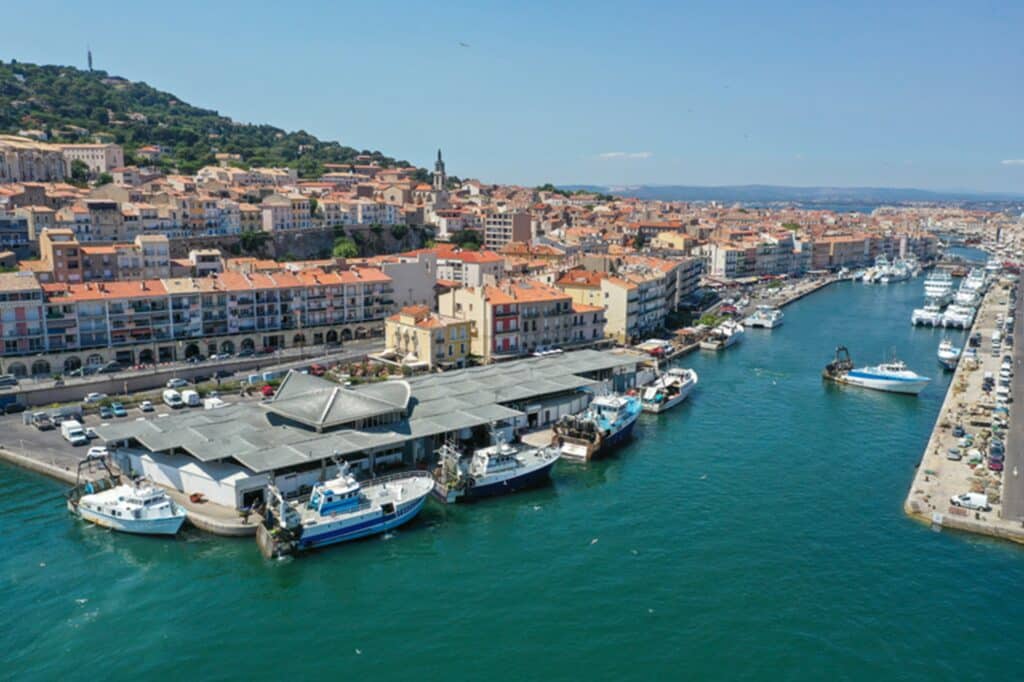
Rehabilitation of the sète fishing port auction house Modernization of the tidal hall Continued modernization and modernization and redevelopment...
The fishing port of Sète, in the south of France, is one of the most important ports on the Mediterranean. Its history dates back to antiquity, but it was only in the 17th century that the town of Sète and its port really began to develop.


Originally, Sète was a small fishing village located on an island between the Mediterranean Sea and the Etang de Thau. In the 17th century, King Louis XIV ordered the construction of the Canal du Midi, linking the Atlantic Ocean to the Mediterranean Sea. Sète was chosen as the mouth of the canal, giving new impetus to the development of the town and its port.
The port of Sète began to specialize in tuna fishing, which became one of the region’s main activities. Sétois fishermen have become renowned for their know-how and traditional fishing techniques, notably “tonnara” fishing, which involves encircling schools of tuna with nets.
Over the centuries, the port of Sète has developed and modernized to meet the growing needs of the industry. Docks, warehouses and infrastructure were built to accommodate the fishing boats and process the catch. Sète has become a major fish processing and marketing center, with the creation of its fish auction.
Today, Sète’s fishing port continues to play a major role in the town’s economic activity. It is home to a fleet of modern fishing boats and a wide variety of species are caught, in addition to tuna, such as cuttlefish, sea bream, hake… over 120 species in all.
The history of Sète’s fishing port is closely linked to the town’s identity and its ties to the sea. It remains an emblematic place where centuries-old traditions meet modernity, offering visitors a fascinating glimpse into the region’s maritime history.
Fleeing economic crises, fishermen from Cetara, an Italian commune in the province of Salerno in Italy’s Campania region, settled in Sète. The Cetareses fish anchovies, and are well acquainted with Sète, where they stop off during bluefish campaigns. In search of a better life, they settled in Sète in waves. Many of them embarked as sailors on Sétois ships.
From the outset, the Sète auction was the first in Europe to be computerized. Renewal of the sales system in 1996 introduced real-time management of buyer deposits.
In 2009, Port Sud de France modernized the sales system at the Sète auction to optimize the value of products, improve the overall operation of auctions and reduce the number of unsold products. This included both top-down and bottom-up auctions.
Inauguration of the Zone Halieutique de Frontignan by French President François Mitterrand.
Following the decentralization of ports, the port of Sète became the property of the Languedoc Roussillon region. It is implementing a major program to rehabilitate and redevelop the commercial and fishing port, including the modernization of tools and infrastructures. The now Occitanie Region decided to create a regional public establishment, Port Sud de France, to manage its ports. The fishing port of Sète comes under the management of Port Sud de France.
The port of Sète is the historic fishing port of the Mediterranean, but it has grown to include three major activities: The fish auction (halle à marée), careening and the fishing industry zone located in the commune of Frontignan.
The Sète fish marketEurope’s first computerized fish market, offers several types of fish and shellfish sales (around 120 species) reserved for fishing industry professionals. Auctions are held either on site in the auction amphitheater or remotely via the Internet, and sales can also be made by mutual agreement. The fishing port of Sète also manages the careening area, equipped with gantry cranes (20 and 300 tons) and a retention system (to protect the environment), enabling fishing and pleasure boats to be landed and maintained. Finally, the Frontignan halieutics zone is dedicated to the establishment of companies in the aquaculture and halieutics sectors.




the fish market
Quai Maximin Licciardi
34200 Sète
Monday to Friday, 9 a.m. to 12 p.m. and 2 p.m. to 7 p.m.
Rehabilitation of the sète fishing port auction house Modernization of the tidal hall Continued modernization and modernization and redevelopment...
Port de Sète © 2023 Legal notice | Site map | Privacy policy | RGAA Charter | Website creation Keole.net
